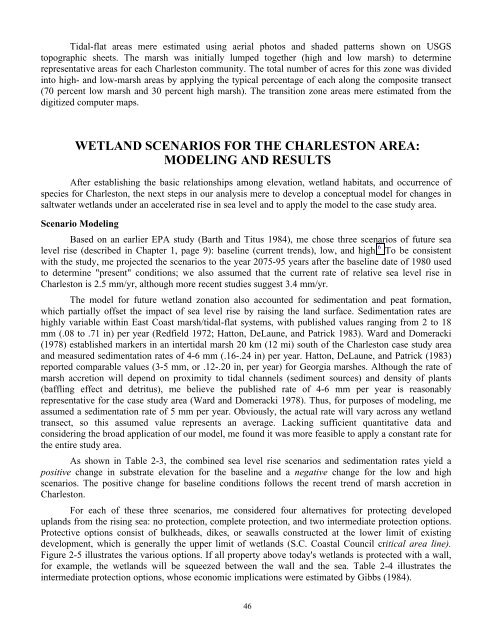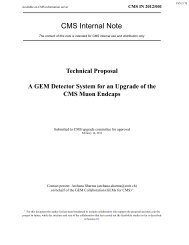Kana et al. 1988. S. Carolina Charleston SLR Case Study
Kana et al. 1988. S. Carolina Charleston SLR Case Study
Kana et al. 1988. S. Carolina Charleston SLR Case Study
You also want an ePaper? Increase the reach of your titles
YUMPU automatically turns print PDFs into web optimized ePapers that Google loves.
Tid<strong>al</strong>-flat areas mere estimated using aeri<strong>al</strong> photos and shaded patterns shown on USGS<br />
topographic she<strong>et</strong>s. The marsh was initi<strong>al</strong>ly lumped tog<strong>et</strong>her (high and low marsh) to d<strong>et</strong>ermine<br />
representative areas for each <strong>Charleston</strong> community. The tot<strong>al</strong> number of acres for this zone was divided<br />
into high- and low-marsh areas by applying the typic<strong>al</strong> percentage of each <strong>al</strong>ong the composite transect<br />
(70 percent low marsh and 30 percent high marsh). The transition zone areas mere estimated from the<br />
digitized computer maps.<br />
WETLAND SCENARIOS FOR THE CHARLESTON AREA:<br />
MODELING AND RESULTS<br />
After establishing the basic relationships among elevation, w<strong>et</strong>land habitats, and occurrence of<br />
species for <strong>Charleston</strong>, the next steps in our an<strong>al</strong>ysis mere to develop a conceptu<strong>al</strong> model for changes in<br />
s<strong>al</strong>twater w<strong>et</strong>lands under an accelerated rise in sea level and to apply the model to the case study area.<br />
Scenario Modeling<br />
Based on an earlier EPA study (Barth and Titus 1984), me chose three scenarios of future sea<br />
level rise (described in Chapter 1, page 9): baseline (current trends), low, and high. 6 To be consistent<br />
with the study, me projected the scenarios to the year 2075-95 years after the baseline date of 1980 used<br />
to d<strong>et</strong>ermine "present" conditions; we <strong>al</strong>so assumed that the current rate of relative sea level rise in<br />
<strong>Charleston</strong> is 2.5 mm/yr, <strong>al</strong>though more recent studies suggest 3.4 mm/yr.<br />
The model for future w<strong>et</strong>land zonation <strong>al</strong>so accounted for sedimentation and peat formation,<br />
which parti<strong>al</strong>ly offs<strong>et</strong> the impact of sea level rise by raising the land surface. Sedimentation rates are<br />
highly variable within East Coast marsh/tid<strong>al</strong>-flat systems, with published v<strong>al</strong>ues ranging from 2 to 18<br />
mm (.08 to .71 in) per year (Redfield 1972; Hatton, DeLaune, and Patrick 1983). Ward and Domeracki<br />
(1978) established markers in an intertid<strong>al</strong> marsh 20 km (12 mi) south of the <strong>Charleston</strong> case study area<br />
and measured sedimentation rates of 4-6 mm (.16-.24 in) per year. Hatton, DeLaune, and Patrick (1983)<br />
reported comparable v<strong>al</strong>ues (3-5 mm, or .12-.20 in, per year) for Georgia marshes. Although the rate of<br />
marsh accr<strong>et</strong>ion will depend on proximity to tid<strong>al</strong> channels (sediment sources) and density of plants<br />
(baffling effect and d<strong>et</strong>ritus), me believe the published rate of 4-6 mm per year is reasonably<br />
representative for the case study area (Ward and Domeracki 1978). Thus, for purposes of modeling, me<br />
assumed a sedimentation rate of 5 mm per year. Obviously, the actu<strong>al</strong> rate will vary across any w<strong>et</strong>land<br />
transect, so this assumed v<strong>al</strong>ue represents an average. Lacking sufficient quantitative data and<br />
considering the broad application of our model, me found it was more feasible to apply a constant rate for<br />
the entire study area.<br />
As shown in Table 2-3, the combined sea level rise scenarios and sedimentation rates yield a<br />
positive change in substrate elevation for the baseline and a negative change for the low and high<br />
scenarios. The positive change for baseline conditions follows the recent trend of marsh accr<strong>et</strong>ion in<br />
<strong>Charleston</strong>.<br />
For each of these three scenarios, me considered four <strong>al</strong>ternatives for protecting developed<br />
uplands from the rising sea: no protection, compl<strong>et</strong>e protection, and two intermediate protection options.<br />
Protective options consist of bulkheads, dikes, or seaw<strong>al</strong>ls constructed at the lower limit of existing<br />
development, which is gener<strong>al</strong>ly the upper limit of w<strong>et</strong>lands (S.C. Coast<strong>al</strong> Council critic<strong>al</strong> area line).<br />
Figure 2-5 illustrates the various options. If <strong>al</strong>l property above today's w<strong>et</strong>lands is protected with a w<strong>al</strong>l,<br />
for example, the w<strong>et</strong>lands will be squeezed b<strong>et</strong>ween the w<strong>al</strong>l and the sea. Table 2-4 illustrates the<br />
intermediate protection options, whose economic implications were estimated by Gibbs (1984).<br />
46
















